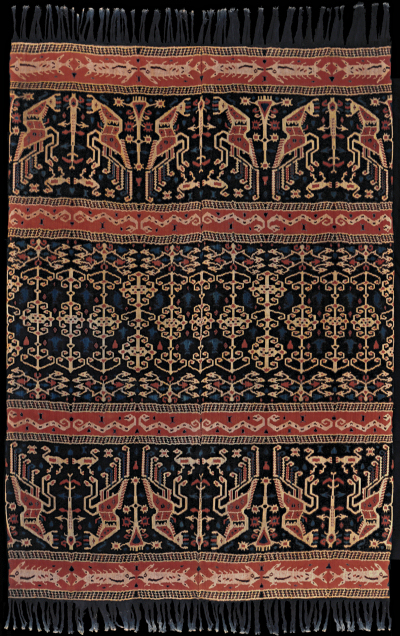| |
187 Sumba, East Sumba
Hinggi (men's blanket)  
|
| Locale: | Kapunduk |
| Period: | 1930-1945 |
| Yarn: | Cotton, hand-spun, fine, double-ply |
| Technique: | Warp ikat |
| Panels: | 2 |
| Size: | 158 x 234 cm (5' 2" x 7' 8") LW: 1.48 |
| Weight: | 935 g (33.0 oz), 253 g/m2 (0.83 oz/ft2) |
| Design: | This uncommonly large (158 x 234 cm), early 20th-century hinggi was cleverly designed and executed with great precision, showing the hand of a master dyer. The hondu wallah is immediately apparent as a result of the three large shrimp per panel half. The kihhil keys that create the axial asymmetry are elegantly hidden. Between the habak motifs on the cloth's axis are two shapes resembling the cross section of a roof that are not axially symmetric (see inset lower left). Two halves are found on the selvedges. Here again we see visual trickery at work. At first glance, the cloth seems to have been made with three repeats of vertical panels decorated with pairs of fishes, pairs of shrimp and pairs of snakes. The centrefield is divided into three by means of a grid-like patterning with stressed verticals in which the eye instantly recognises three identical groups of elements: habak in between motifs consisting of nesting inward curls similar to those that compose the habak motifs, but wider. The three groups are separated by columns that contain the same visual elements (including the kihhil keys) but in another order. |
| Comment: | |
| Background: | Chapters on Sumba and East Sumba. |
| Exhibited: | Hong Kong University Museum and Art Gallery, 2017. |
| Published: | Ikat Textiles of the Indonesian Archipelago, 2018.
Noble Virtuosity: Hidden Asymmetry in Ikat from Sumba, 2024. |
| Compare: | 188 027 319 |
| Sources: | The patola motif is similar to that seen on hinggi depicted on a photo (undated) made at the funeral of the king of Kapunduk, shown in Khan Majlis, Woven Messages, Fig. 204, and to that of a much younger hinggi on Fig. 215. |
| |

©Peter ten Hoopen, 2025
All rights reserved.
|


